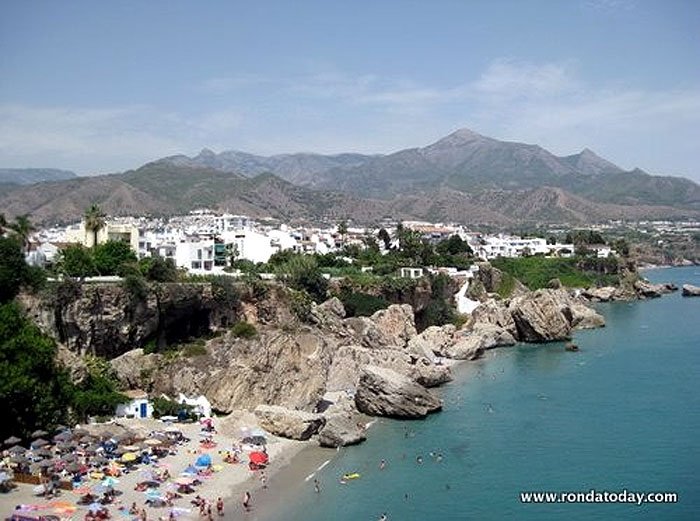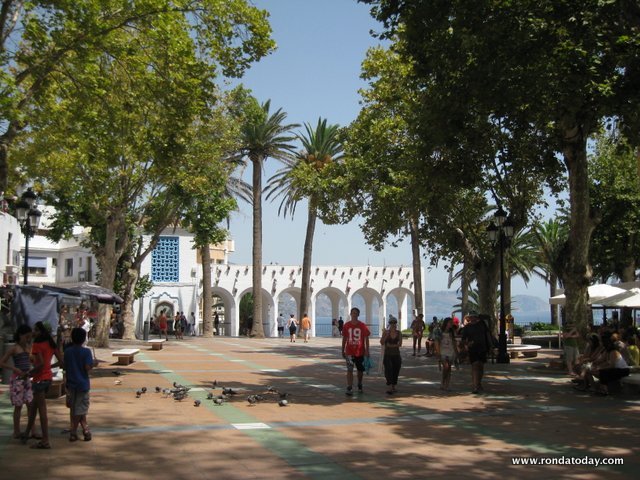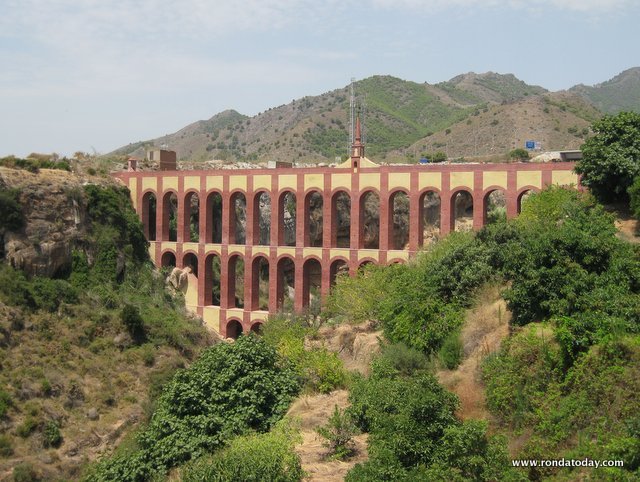Visitors to Ronda find the city to be a wonderful location from which to explore the rest of Andalucia, and the Axarquía coast is within reach if you like road trips! (i.e. its quite a long way!) Most people go to Nerja in order to visit the Nerja Caves.
Nerja is one of the gems of the south coast of Spain. It is about 40 minutes drive from Malaga, not much more from Malaga airport, and from Ronda about 2.5 to 3 hours. There and back it’s quite a long drive so we would recommend staying overnight or a couple of days to really explore the town and all it has to offer.
From Malaga, the road to Nerja is a pleasurable drive, the Mediterranean on one side and the Sierra de Almijara mountains on the other, and it is for this reason Nerja is known as the pearl of the Costa Axarquia, though the Costa Tropical with all year round perfect weather is so close to Nerja that it’s easy to understand why Nerja is so popular.

The caves and other activities
The caves at Nerja are an obvious drawcard, with the world’s largest stalactite, but also the cave paintings that are now known to be have been drawn by some of the last surviving Neanderthal folk.
But the town shouldn’t be missed just because the Nerja caves are nearby. Nerja’s town centre is an attractive place to wander around in the old quarter looking at the shops, courtyards of people’s homes, or enjoying the smells of restaurants and bakeries.
The Balcon de Europa
The ‘Balcon de Europa’ is here too, the place where in the 19th century royalty from all over Europe would visit, and where now the promenade is filled with cafés, buskers, and stalls. There is a statue of King Alfonso XII in bronze, the town church, and a covered walkway overlooking the cove beach below.

The Balcon de Europa is also where you’ll find the tourism office. The town hall is just next to the church, and the entire plaza is only 100 metres long so you shouldn’t have any trouble finding it! :)
The aqueduct
Outside Nerja on the way to the caves, be sure to stop and admire the El Aguila aqueduct built by Francisco Cantarero Senio to supply water to his sugar factory “Las Mercedes” at the end of the 19th century.

The aqueduct was built in mudejar style, is four stories high with a total of 37 half point arches, and made from brick kilned locally. The aqueduct is still used to this day, though only for irrigation, and has recently been restored to last another 100 years.
FAQ: Exploring Nerja and Beyond from a Ronda Base
Ronda’s compact layout, central location, and rich history make it a strategic hub for Andalusian travel. Major sites like the Puente Nuevo, El Tajo gorge, and Real Maestranza bullring are all within a short walk. With options like the VoiceMap GPS Audio Guide and guided walking tours, visitors can immerse themselves in the city’s charm and also reach coastal regions like the Axarquía for an overnight stay in Nerja.
Nerja is a coastal town famous for the Nerja Caves, home to the world’s largest stalactite and prehistoric cave paintings. Other highlights include the Balcón de Europa, the El Águila aqueduct, and nearby Frigiliana, a picturesque white village. From Ronda, Nerja is around a 3-hour drive, making it better suited for a day trip from Málaga or an overnight stay if coming from Ronda.
The Balcón de Europa is a scenic promenade built on a former fortress, offering panoramic Mediterranean views. It features a statue of King Alfonso XII, café terraces, live performers, and easy access to local beaches. Located in the heart of town, it’s the perfect starting point for exploring Nerja’s old quarter and nearby shops, the Iglesia de El Salvador, and the tourist office.
Located near the Nerja Caves, the El Águila aqueduct is a 19th-century Mudejar-style structure with 37 brick arches across four levels. Built to support a sugar factory, it remains in use today for irrigation. Recently restored, it stands as one of Andalusia’s hidden gems for architecture lovers and is a quick stop along most Nerja day trip routes.
Run by Clive Muir, the Ronda Today network offers detailed guides for destinations like Ronda, Cádiz, Grazalema, and the Caminito del Rey. His sites include hotel recommendations, timetable info, walking holidays through Wildside Holidays, and forums like Iberia Nature Forum. Bookings made through these sites help keep the information free and up to date.
I’ve been living in this lovely area of Western Andalucia for the last 20 years or so and dedicate most of my time to the running of English language tourist information websites for the towns of Cádiz, Ronda, Grazalema, the famous or infamous Caminito del Rey, and also Wildside Holidays, which promotes sustainable and eco-friendly businesses running wildlife and walking holidays in Spain. My articles contain affiliate links that will help you reserve a hotel, bus, train or activity in the area. You don’t pay more, but by using them you do support this website. Thankyou!

2 thoughts on “A Daytrip to Nerja from Ronda”